DFDS Seaways
DFDS is sometimes overlooked when people name the companies that survive today from the oceanliner era. This company was formed in Denmark in 1866 under the name of Det Forenende Dampskibs Selskap, meaning The United Steamship Company. United, because it was a merger of a few small companies. Some 19 ships were registered under DFDS ownership when they started operations on january the 1st 1869. The new combination was lead by Carl Frederik Tietgen, a merchant from Odense. In 1898, the Thingvalla Linie was taken over. This was a company that was founded in 1879 for the purpose of sailing a passengerline between Copenhagen and America. This service called also at Kristiania, today called Oslo, and Kristiansand to collect Norwegian passengers. Before 1879, the Danish immigrants were mostly carried by the big German companies HAPAG and Norddeutscher Lloyd and because of this Thingvalla had a big challenge to win over the Danish immigrants. Also, by using the two Norwegian ports, they could attract Norwegian immigrants, that normally would travel by English companies.
The line became very popular with Scandinavian people, because they now could be served by people that spoke their own language while they were on route to the New World. The ships were smaller and slower then the rivals from Germany and England, but this did not bother the Scandinavians. But the company suffered some terrible accidents and this did no good for their reputation.
When Thingvalla was taken over by DFDS in 1898, the company was renamed Scandinavian America Line. DFDS immidiately ordered three new steamers, Oscar II, Hellig Olav and United States to modernize the aging fleet. These ships brought a new modernized standard to the company and it soon became profitable. These ships did not carry steerage passengers, but they used the term thirth class, where also spacious staterooms were available, for two, four or six persons. There was drinkingwater, sheets, beds, matrasses, soap and more luxuries available to these thirth class passengers, now very normal but at that time it was unique. Other transatlantic lines used steerage dormitories with nothing that was offered to the immigrants.
In 1914, the Svenska Amerika Linje was opened, a transatlantic service between Göteborg and New York, followed by Den Norske Amerikalinje in 1917 from Kristiania to New York. The Norwegians and Swedish started choosing for these companies so it became hard for DFDS to attract passengers from these countries. After that, the Great War broke out, the immigrationlaws in America were put into action and at the end of the 1920's Wallstreet collapsed and brought the world in a deep recession. The Scandinavian America Line did not recover and stopped sailings in 1935.
Besides the Scandinavian America Line, DFDS operated the route between the Danish port of Esbjerg and Thamestown near London from 1873 onwards. Thamestown changed to Harwich over the years and new routes were added from Esbjerg to Hamburg, Grimsby, London and Newcastle. These were most of all used for the carring of lifestock, but later also changed to general freight and also passengers. In the 1880's, he company began also sailings to the Mediterranean and the Black Sea and they became one of the ten largest shipowning companies in the world. In fact, when the number of ships was used as measure, DFDS was the biggest company in the world by then.
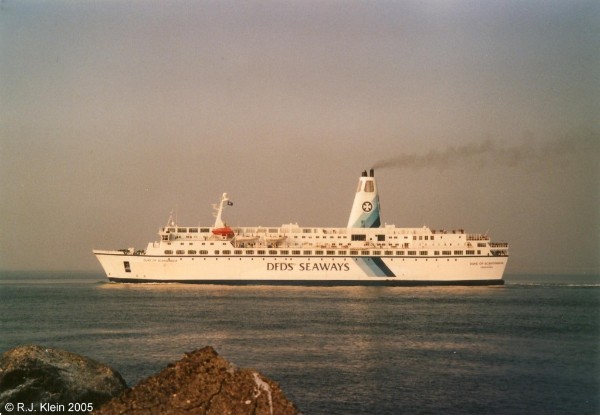
Duke of Scandinavia in 2005 leaving IJmuiden for Newcastle.
After the closure of the Scandinavian America Line, more routes were added by DFDS in Northern Europe. In the second worldwar, the company lost 31 ships and 300 people, a big loss of course for the company. After the war, the fleet was rebuilt and closed routes opened again. DFDS built more motorships and in 1949 the motorships outnumbered the steamships.
In the middle of the 1960's the first ro-ro passenger/carferries entered the fleet. The first of these ships was the Akershurs, sailing from 1965 on in the Frederikshavn-Oslo service. In 1966 the last steamship left the fleet and in january 1967 the white cross logo was introduced at the ships funnels. These years were the startingpoint of the company as we know today, that also sailed a cruiseservice in the 1970's under the name of Scandinavian World Cruises, later SeaEscape. In 1978 the Dana Anglia entered the fleet, the ship pictured above under her new name Duke of Scandinavia. In that same year, DFDS started also working together with Tor Line, a company that also sailed passenger and freight routes in Northern Europe. Also, the company entered roadtransport businesses.
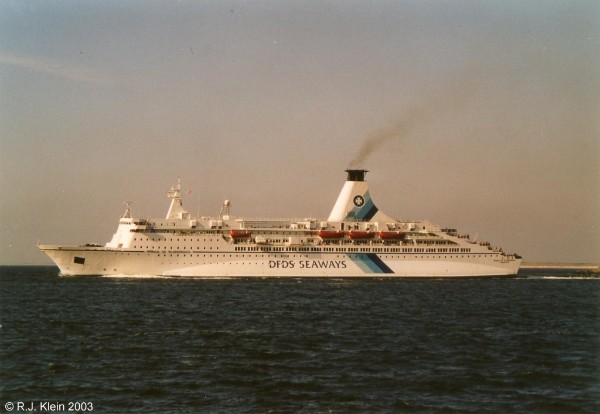
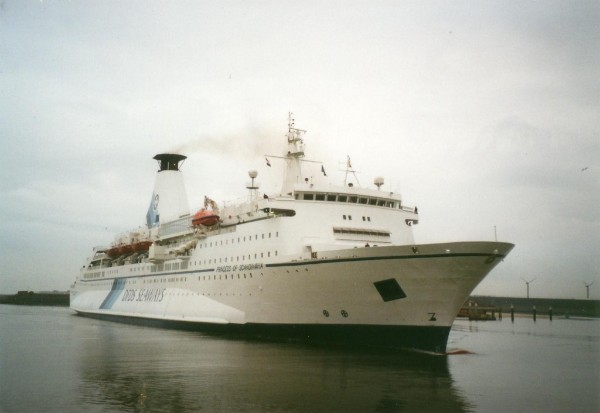
Prince of Scandinavia (above) and Princess Of Scandinavia (below) both at IJmuiden in 2003 and 2006. Now they are both sailing for Moby Lines in the Mediterranean.
In the 1980's the company reorganized drasticluy and sold some interests they had in several ferrycompanies like Mols Linie and Nordana Line. In 1988 the name Scandinavian Seaways was introduced for their passengerservices. One year later, DFDS Transport started up air-freight activities and expanded logistics onshore.
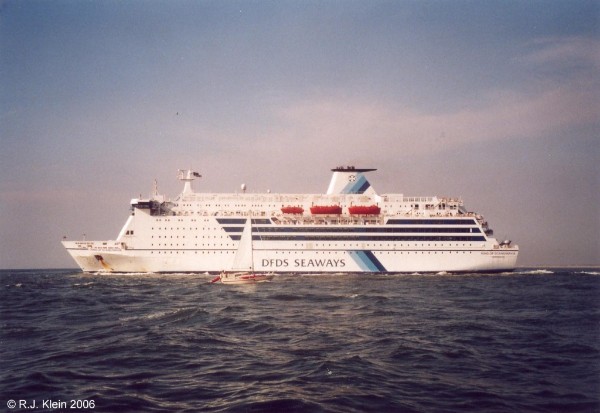
King Of Scandinavia (III) in 2006 at IJmuiden This modern ferry was reunited with her sister Princess Of Norway on the route from 2007 onwards.
Throughout the 1990's lots of companies were taken over and added to the group, even some terminals of Volvo and Stora-Enzo in Venlo (Holland), Immingham, Birmingham and Manchester (England). In 1998 it was decided to use the name DFDS again in all parts of the company, so Scandinavian Seaways was renamed DFDS Seaways. New ships were bought, new routes were opened and some were closed.
A very important aquisition for DFDS came on the 12th of july 2010, when the Norfolk Line was taken over. Untill then, Norfolk Line has been a part of the Moller-Maersk group and the company sails several freight and passengerroutes in Northern Europe. DFDS announced that, after the take-over of Norfolk Line, the company would be restructured and simplified. This means that all parts of the group that are directly involved in shipping, mainly DFDS Tor Line, DFDS Seaways, Norfolk Line and DFDS Lisco, among others, will be branded as DFDS Seaways. All other names will dissappear. Also very important are the road- railway and containeractivities of the company and these will all be rebranded as DFDS Logistics. Also, the names of the ships are changed. Because the company is now operating in many different parts of the world outside of Sandinavia, the passengerships lost their 'Of Scandinavia'-names that were introduced in the 1990's. Instead of this, their names now ended at 'Seaways', like all ships within the rest of the DFDS fleet.
Below, King Seaways is seen departing IJmuiden at the 21st of april 2013. She is painted in the new colouring sceme of DFDS Seaways, introduced in 2011.
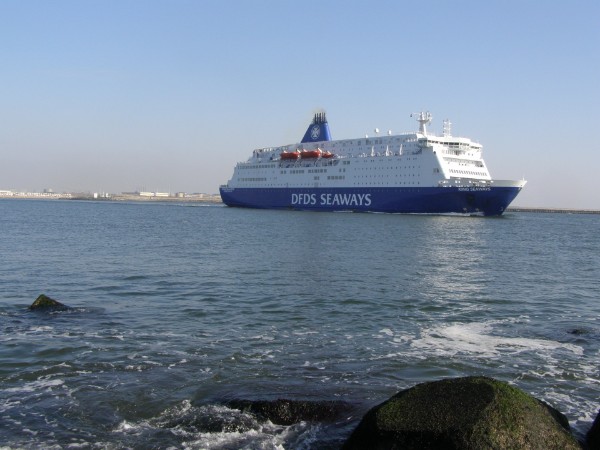
For booking information, visit the website of DFDS Seaways

